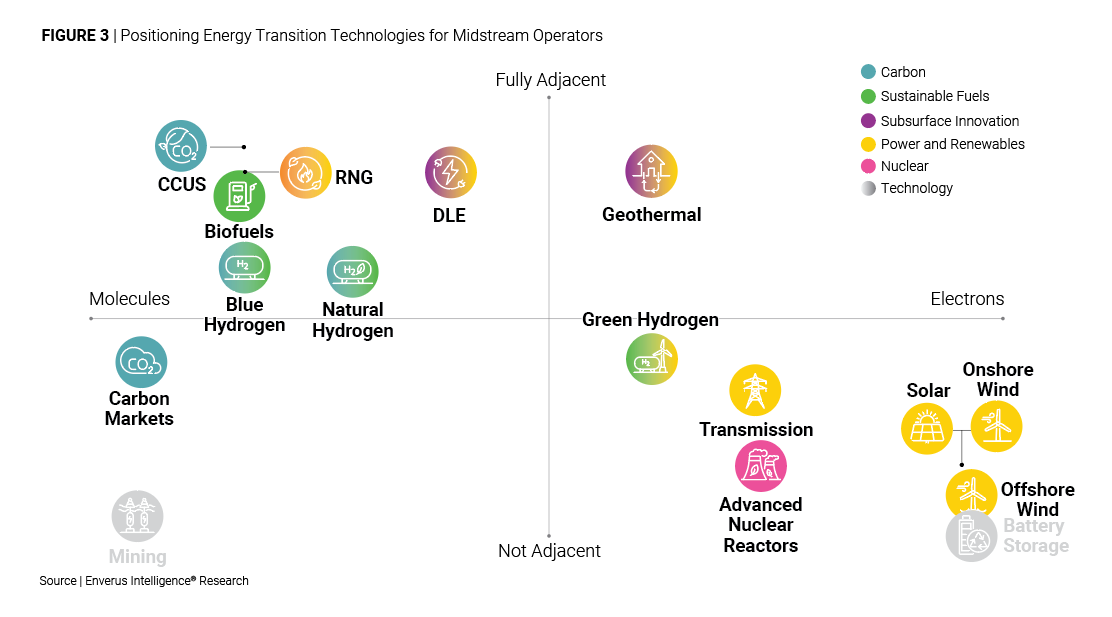Explore how midstream business models align most effectively with emerging energy transition opportunities and gain insights into the optimal pathways for midstream companies to participate in the energy transition.
Research written by:
Carson Kearl, Sr. Associate, [email protected]
Morgan Kwan, P.Eng., Director, [email protected]
Ian Nieboer, P.Eng., CFA, Manager Director, [email protected]
This E-book is Based off the Report Published by the Enverus Energy Transition Research team, Ways to Play | Energy Transition Opportunities for Midstream Participants, Published on Sept. 18, 2023. Enverus Intelligence Research clients can view the full report here.
Enverus Intelligence® Research, Inc., a subsidiary of Enverus, provides the Enverus Intelligence® | Research (EIR) products. See additional disclosures.

The energy transition is happening. While it may be viewed as a major headwind by some traditional upstream oil and gas operators, Enverus Intelligence® Research (EIR) sees opportunity in the numerous business models that are emerging around transition technologies and the policies implemented to support them.
With the flurry of buzzwords and headline technologies, it is easy to be overwhelmed with what exactly the energy transition entails and how much effort, if any, should be invested toward it. EIR’s holistic approach to analyzing the energy transition space helps facilitate developing a strategy that goes beyond targeting net-zero emissions, to create a strategy that is accretive to your business.
The rise of investor preference toward operators who are participating in the transition presents a unique set of opportunities to diversify revenue streams and gain favor in the public eye. This guide is a framework for operators to create a strategy that suits a scale and scope unique to them.
A midstreamer’s strategy will depend on the unique context of its business, the capability of its skill sets and ultimately its conviction around the energy transition. Each midstream operator will have a unique position in each of these areas and for different transition technologies, and therefore a unique, but necessary, strategy.


Midstream companies’ assets and most often geographical location strategically position them to bridge the gap between traditional energy sources and the emerging renewable ones. This unique context leverages their infrastructure, logistics and market knowledge for them to play a pivotal role in the transportation, storage and distribution of renewable energy sources. The capabilities within midstream organizations, like assets for transporting hydrocarbons and fuels and established processes for permitting and rights of way, make some molecule-centered transition technologies a more natural fit.
Adjacencies in skills and resources can provide a competitive edge, allowing for smoother integration and optimization of innovative technologies. The question for midstream entities then becomes, Does our current capability landscape not only support but also enhance our position in the evolving energy transition space? Scalability and adaptability are paramount; the ability to evolve and grow in this dynamic environment will determine success in the energy transition journey. For each technology, EIR assesses its alignment with a midstream company’s operations.

When thinking about adjacency, they’re considering how well an organization’s current assets, business model and expertise align with the energy transition technology in question. Technologies that are fully adjacent, from a technical and business model standpoint, enhance revenue streams by capitalizing on existing infrastructure or tapping into incentive schemes like Inflation Reduction Act credits.
On the other hand, partially adjacent technologies open new avenues of revenue, grounded in a company’s established infrastructure and expertise, such as facilitating new product transportation, carbon capture and storage (CCS) or produced water for direct lithium extraction (DLE).
Enverus Energy Transition Research (ETR) evaluates many of the technologies that are part of the energy transition, focusing on those that attract the most investor interest and capital flow. Below are details on the various technologies and how a midstream operator can incorporate them in their transition strategy.
RNG, also known as biomethane or upgraded biogas, is derived from organic materials such as agricultural residues, wastewater sludge, municipal solid waste or livestock manure. RNG can serve as a direct substitute for conventional natural gas because it’s chemically similar, being primarily methane.
RNG offers midstream operators a sustainable alternative to conventional natural gas for transportation and storage. RNG can be integrated into existing midstream infrastructure, providing a greener option for pipelines, storage facilities and distribution networks.
Biogas production
Organic waste is decomposed anaerobically (in the absence of oxygen) in digesters or landfills to produce biogas.
Upgrading
The biogas, a mixture of methane, carbon dioxide and impurities, is processed to remove contaminants and CO2 to create high-quality RNG.
Integration
Once cleaned and upgraded, RNG can be injected into existing natural gas infrastructure or utilized for various applications, from electricity generation to transportation fuel.
Carbon markets, also known as cap-and-trade systems or emissions trading systems, are market-based approaches used to control greenhouse gas (GHG) emissions by providing economic incentives for businesses to reduce their carbon footprint.
Midstream companies play a crucial role in the carbon market, as they can reduce emissions from transportation and storage processes. By participating in carbon trading, midstream operators can monetize their emission reduction efforts, turning potential regulatory challenges into economic opportunities.
Cap
Governments or regulatory bodies set a maximum limit or cap on the total amount of GHGs that can be emitted by certain sectors of the economy. This cap is usually reduced over time, aiming to decrease overall emissions.
Allocation
Once the cap is set, emission allowances (often equivalent to one ton of carbon dioxide) are either given away to emitters or auctioned off.
Trading
Companies that emit less than their allocated amount can sell or trade their extra allowances on the carbon market. Conversely, companies that exceed their limits can buy additional allowances from those with excess.
Banking and borrowing
In some systems, companies can bank unused allowances for future use or borrow against future reductions.
Offsets
In addition to trading allowances, some systems allow for carbon offset credits. These are credits earned from projects that reduce, avoid or sequester emissions outside of capped sectors, like afforestation or renewable energy projects.
A set of technologies and processes that capture CO2 emissions at their source and either utilize them in various applications or permanently store them underground. CCUS plays a vital role in addressing climate change, especially in sectors where decarbonization is challenging.
Midstream operators can transport CO2 from source to sink or integrate CCUS technologies into their infrastructure, capturing emissions from transportation processes. By utilizing or storing captured CO2, midstream companies can reduce their carbon footprint and potentially develop new revenue streams from selling captured carbon.
Capture
This is the process of capturing CO2 emissions directly from industrial processes or directly from the atmosphere. Various technologies can be used, including post-combustion capture, pre-combustion capture, oxyfuel combustion and direct air capture.
Utilization
Captured CO2 can be used in various applications. Examples include:
Storage
If not utilized, the captured CO2 can be transported and stored underground in geological formations, such as depleted oil and gas reservoirs or deep saline aquifers.
DLE is a term used to describe a range of technologies designed to extract lithium directly from brine sources more rapidly and efficiently than traditional evaporation pond methods.
While DLE primarily impacts upstream operations, midstream companies can benefit by transporting and storing extracted lithium. As demand for lithium (used in batteries) grows, midstream operators can diversify their portfolios by facilitating its distribution.
Blue hydrogen refers to hydrogen produced from natural gas generally through a process called steam methane reforming, where the CO2 byproduct is captured and stored using CCS technology. This process reduces the carbon emissions typically associated with traditional hydrogen production methods, making the hydrogen “blue.”
Midstream companies can transport and store blue hydrogen, offering a cleaner energy carrier for distribution. With existing natural gas infrastructure, midstream operators can adapt to the increasing demand for blue hydrogen, especially in regions transitioning to cleaner energy sources.
Steam methane reforming
Natural gas (primarily methane, CH4) is reacted with steam to produce hydrogen and CO2. The primary reaction is: CH4+ H2O = CO + 3H2.
Carbon capture and storage
The CO2 produced from steam methane reforming is captured and then transported and stored underground in geological formations to prevent its release into the atmosphere.
Green hydrogen is produced using renewable energy sources, primarily through the electrolysis of water. Electrolysis splits water (H2O) into hydrogen (H2) and oxygen (O2) using electricity. When the electricity used for this process comes from renewable sources such as wind, solar or hydro, the resulting hydrogen is termed “green,” since the production process is carbon-free.
Green hydrogen presents midstream operators with opportunities in transportation and storage. As the demand for green hydrogen grows, midstream infrastructure can be adapted or expanded to accommodate this clean energy carrier, tapping into a burgeoning market.
Electrolysis
Water is passed through electrolyzer that applies an electric current to split water molecules into hydrogen and oxygen.
Renewable energy integration
For hydrogen to be considered green, the electricity used in electrolysis should come from renewable sources. This ensures that the entire hydrogen production process is carbon neutral.
Advanced nuclear reactors, often referred to as small modular reactors (SMR), present a compact alternative to traditional nuclear reactors. They can be manufactured at a plant and brought to a site to be fully constructed, allowing for less on-site construction, increased containment efficiency and enhanced safety due to their smaller reactor core.
While advanced nuclear reactors primarily impact power generation, midstream companies can play a role in transporting and storing nuclear fuel and waste. This offers diversification opportunities for midstream operators looking to expand into the nuclear sector.
Modularity
SMRs are designed to be modular, meaning they can be manufactured in a factory and transported to their intended location. This approach aims to reduce construction times and costs.
Scalability
Their modularity also means multiple advanced reactors can be deployed together to achieve the desired capacity, offering flexibility and scalability in power generation.
Safety features
Advanced reactors often incorporate passive safety features that rely on natural forces like gravity and natural circulation, reducing the need for external power or active cooling systems.
Geothermal energy harnesses the Earth’s natural heat stored beneath the surface, utilizing it for electricity generation or direct heating. This renewable energy source is consistent, as it does not rely on intermittent factors like sun or wind.
Geothermal energy, while primarily a power generation source, requires infrastructure for transporting heat in the form of water or steam. Midstream operators can leverage their expertise in pipeline and storage solutions to support the geothermal industry.
Heat extraction
Geothermal systems extract heat from the Earth through deep wells that tap into hot water and steam reservoirs.
Electricity generation
In geothermal power plants, the heat from the Earth’s core is used to heat water or another working fluid to produce steam. This steam drives a turbine connected to a generator, producing electricity.
Direct use applications
Geothermal heat can also be used directly for heating buildings, growing plants in greenhouses, drying crops, heating water at fish farms and several industrial processes such as pasteurizing milk.
Renewable energy generation, specifically solar and wind, has witnessed rapid growth due to increasing demand for sustainable energy, technological advancements and decreasing costs. While solar captures energy from the sun through photovoltaic (PV) cells or concentrating solar power systems, wind energy taps into the kinetic energy from wind to turn turbines and generate electricity.
As renewable energy generation grows, midstream operators can diversify by transporting and storing renewable energy sources. For instance, storing energy in battery solutions can be a potential avenue for midstream companies to explore.
Solar energy
Wind energy
Wind turbines transform the kinetic energy from the wind into mechanical energy. This mechanical energy is then converted into electrical energy through a generator.
Discover
About Enverus
Resources
Follow Us
© Copyright 2024 All data and information are provided “as is”.